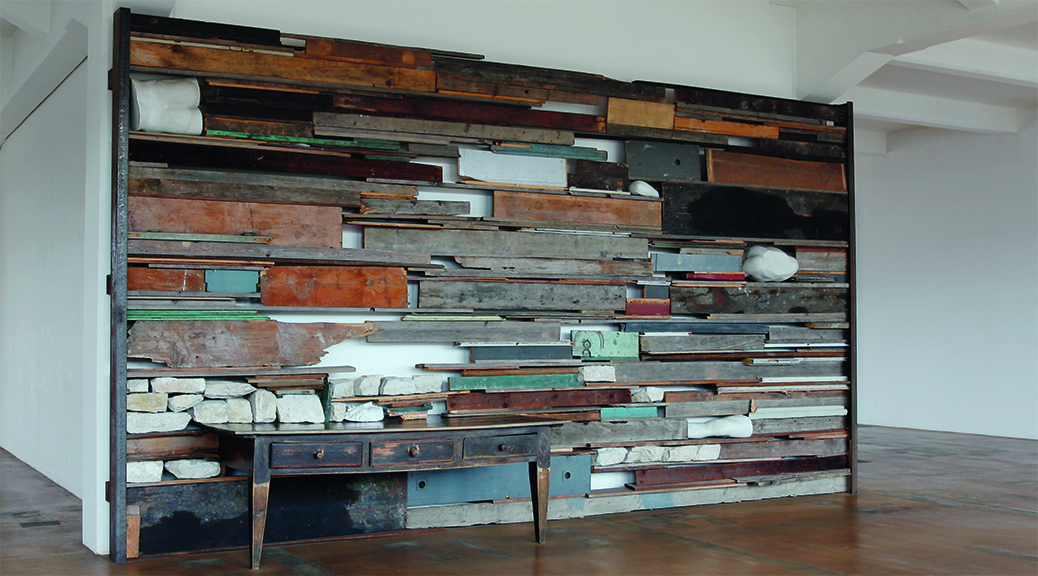Jannis Kounellis
Senza titolo (metamorfosi), 1984
Das für die neu entstandenen Hallen für Neue Kunst geschaffene Werk führt uns Geschichte buchstäblich als Schichtung vor Augen. Kounellis hat mit Steinen und Brettern aus den Trümmern eines abgebrochenen Schaffhauser Hauses eine Mauer gebaut, die in ganzer Breite die Wand bedeckt, vor der sie steht. Jedes Brett ist in seiner Eigenart ausgewählt und mit den Spuren seiner Benutzung ins Licht gerückt. Doch nicht nur Schaffhausen ist in das Werk eingeflossen. Wie in Rom, wo der Grieche Kounellis lebte, finden sich spolienartig Fragmente in der Mauer: Bruchstücke des Abgusses einer griechischen Statue, die als Apollo gedeutet wird. Auf dem Tisch, der die lose Schichtung mitträgt, liegt die Maske des Musengotts, als würde sie den schöpferischen Künstler vertreten.
Motiviert durch die Transformation der Schaffhauser Textilfabrik in ein Kunstmuseum hat Kounellis den Ort und seine Geschichte in ein grosses Thema eingebunden: die Verwandlung einer Form in eine andere. Es ist, als führte er uns auf eine Bühne, auf der ein kleiner Ausschnitt aus der Weltgeschichte zu erleben ist. Das Besondere dabei ist, dass das Bild, das uns Kounellis präsentiert, nicht fiktiv ist. Jeder Teil davon ist, was er ist; doch wird die Realität, der wir hier begegnen, vom Künstler mit Poesie beseelt. Die Veränderung nimmt in seinem Werk Gestalt an, und in physischer Verdichtung tritt uns die Überzeugung entgegen, dass nur ein Bewusstsein für die geschichtlichen Zusammenhänge uns in die Lage versetzt, unseren Standpunkt heute zu bestimmen.
„Senza titolo (metamorfosi)“ war ein Teil einer grösseren Situation in den Hallen für Neue Kunst, in der Kounellis durch die Wahl und Platzierung verschiedener Werke das Spezifische des Orts mit den Grundzügen seines Weltbilds zu einer umfassenden Aussage zusammengebunden hatte.Jannis Kounellis
Senza titolo (metamorfosi), 1984
This work, created especially for the newly founded Hallen für Neue Kunst, literally visualizes history as stratification. Kounellis had built a wall with stones and boards from the ruins of a broken-down Schaffhausen house; it covers the entire wall that it stands in front of. Each board was selected for ist uniqueness and highlighted by the traces of use it encountered. But not only Schaffhausen found a place in this work. As in Rome, where Kounellis lived, fragments appear in the wall like spolias: pieces of a cast of a Greek statue that is seen to be Apollo. The god of the muses‘ mask lays on the table that helpes shoulder the layers; it is as though it were representing the creative artist.
Motivated by the transformation of the Schaffhausen textile factory into an art museum, Kounellis had tied the location and its history to a larger subject: the metamorphosis of one form into another. It is as though he is leading us onto a stage where a small section of world history could be experienced. The special thing: the image Kounellis presents to us is not fictional. Every part of it is what it is; however, the artist gave a poetic soul to the reality that we are faced with here. Change took on a shape in his work, and in the physical concentration we are confronted by the conviction that only consciousness of historical relationships puts us in a position to determine our own point of view today.
„Senza titolo (metamorfosi)” was part of a larger situation within the Hallen für Neue Kunst in which Kounellis, by selecting and placing different works, had bonded together the specific with the fundamental to form a general statement.
